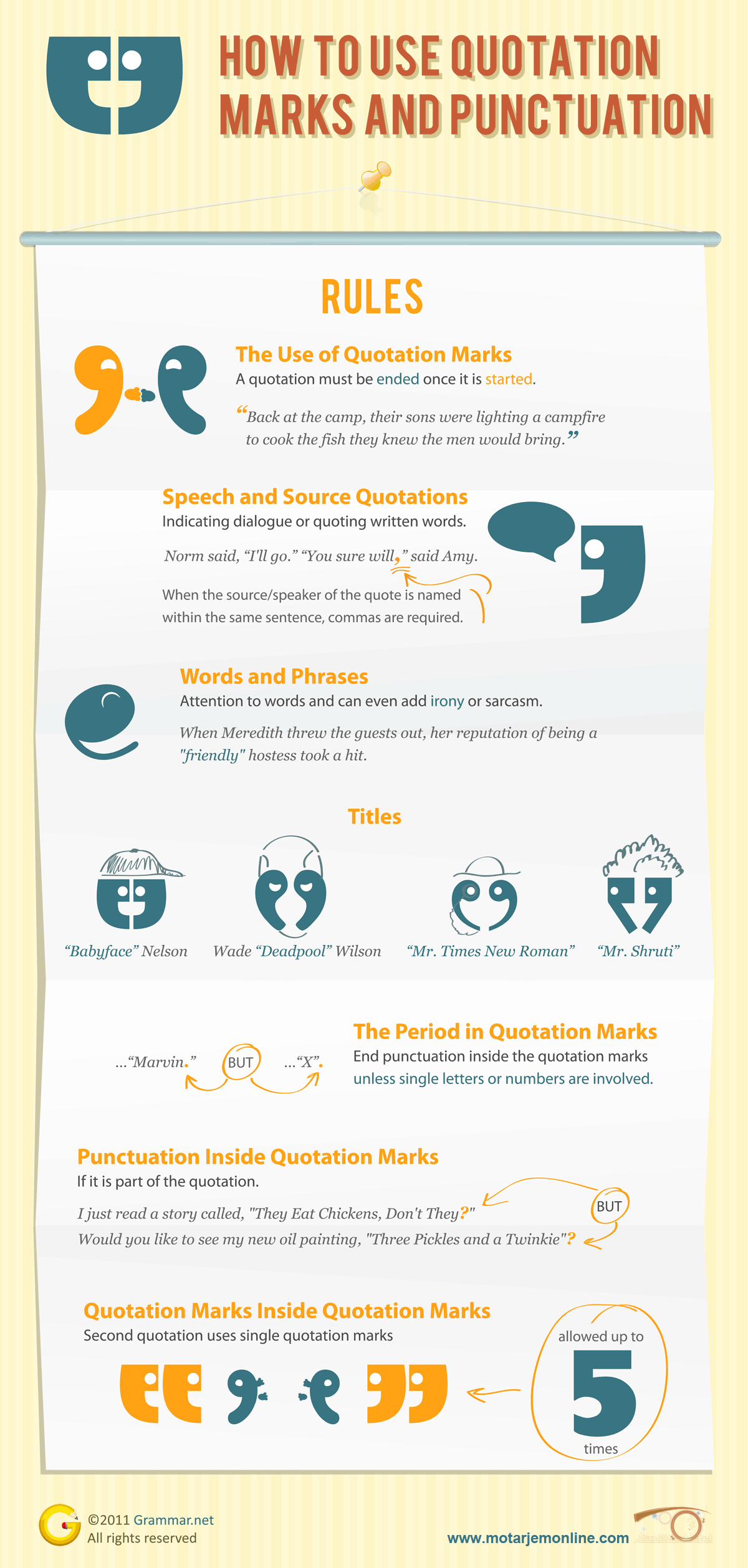How to use quotation marks and punctuation
Single quotation marks? Double quotation marks? They can seem intimidating, but when the purpose of quotation marks is understood, the rules are easier to follow.

The Use of Quotation Marks
Quotation marks set apart statements or words, adding a loud emphasis to whatever they surround. The most basic rule is that a quotation must be ended once it is started. If the end of a paragraph is reached, no end quotation mark is used if the quotation continues, but another at the beginning of the following paragraph indicates the continuation.
“When the men reached the shore, they tied their boats to the bushes. After a short rest, they began unloading their fishing gear.
“Back at the camp, their sons were lighting a campfire to cook the fish they knew the men would bring.”
Speech and Source Quotations
When indicating dialogue or quoting written words, use quotation marks. When the source/speaker of the quote is named within the same sentence, commas are required.
The manual listed the steps. “Unplug the machine, then remove the screws.” Bill grabbed his screwdriver.
Norm said, “I’ll go.” “You sure will,” said Amy.
Words and Phrases
Quotation marks call attention to words and can even add irony or sarcasm.
In ancient writing, “leprosy” was used to indicate any sort of skin condition.
When Meredith threw the guests out, her reputation of being a “friendly” hostess took a hit.
Titles
Quotation marks enclose the title of short written/artistic/musical works, and they indicate nicknames.
Alphonse “Scarface” Capone; “Babyface” Nelson; Sammy “the Bull” Gravano
After reading “Nick the Narwhal,” he was inspired to paint “Ode to a Whale” while singing “We All Live in a Yellow Submarine.”
The Period in Quotation Marks
American English finishes a sentence with the end punctuation inside the quotation marks unless single letters or numbers are involved.
Misty named her new horse “Marvin.”
He bit her, and she said, “Stop that!”
I asked how old Marvin is, and she said “4″.
To warn others, she marked his stall with a big red “X”.
Punctuation Outside Quotation Marks
If it is part of the quotation, keep the punctuation inside. In the first example, the question mark is part of the title, while the second example is a question.
I just read a story called, “They Eat Chickens, Don’t They?”
Would you like to see my new oil painting, “Three Pickles and a Twinkie”?
Quotation Marks Inside Quotation Marks
When a quotation is within another quotation, the second quotation uses single quotation marks: ‘. It is more simple to keep track of alternating quotation marks, and it is allowed up to five times: ” ‘ ” ‘ ” ” ‘ ” ‘ “. When they follow each other, a space is required for better readability.
“I am busy,” she said, “reading ‘This Week’s Movies.’ ”
The words “quote” and “quotation” are often used interchangeably, but they have unique uses.

The Use of Quotation Marks
Quotation marks set apart statements or words, adding a loud emphasis to whatever they surround. The most basic rule is that a quotation must be ended once it is started. If the end of a paragraph is reached, no end quotation mark is used if the quotation continues, but another at the beginning of the following paragraph indicates the continuation.
“When the men reached the shore, they tied their boats to the bushes. After a short rest, they began unloading their fishing gear.
“Back at the camp, their sons were lighting a campfire to cook the fish they knew the men would bring.”
Speech and Source Quotations
When indicating dialogue or quoting written words, use quotation marks. When the source/speaker of the quote is named within the same sentence, commas are required.
The manual listed the steps. “Unplug the machine, then remove the screws.” Bill grabbed his screwdriver.
Norm said, “I’ll go.” “You sure will,” said Amy.
Words and Phrases
Quotation marks call attention to words and can even add irony or sarcasm.
In ancient writing, “leprosy” was used to indicate any sort of skin condition.
When Meredith threw the guests out, her reputation of being a “friendly” hostess took a hit.
Titles
Quotation marks enclose the title of short written/artistic/musical works, and they indicate nicknames.
Alphonse “Scarface” Capone; “Babyface” Nelson; Sammy “the Bull” Gravano
After reading “Nick the Narwhal,” he was inspired to paint “Ode to a Whale” while singing “We All Live in a Yellow Submarine.”
The Period in Quotation Marks
American English finishes a sentence with the end punctuation inside the quotation marks unless single letters or numbers are involved.
Misty named her new horse “Marvin.”
He bit her, and she said, “Stop that!”
I asked how old Marvin is, and she said “4″.
To warn others, she marked his stall with a big red “X”.
Punctuation Outside Quotation Marks
If it is part of the quotation, keep the punctuation inside. In the first example, the question mark is part of the title, while the second example is a question.
I just read a story called, “They Eat Chickens, Don’t They?”
Would you like to see my new oil painting, “Three Pickles and a Twinkie”?
Quotation Marks Inside Quotation Marks
When a quotation is within another quotation, the second quotation uses single quotation marks: ‘. It is more simple to keep track of alternating quotation marks, and it is allowed up to five times: ” ‘ ” ‘ ” ” ‘ ” ‘ “. When they follow each other, a space is required for better readability.
“I am busy,” she said, “reading ‘This Week’s Movies.’ ”
The words “quote” and “quotation” are often used interchangeably, but they have unique uses.

